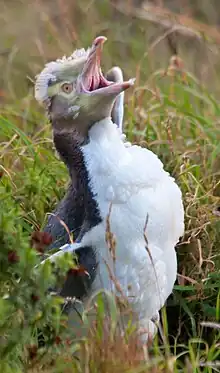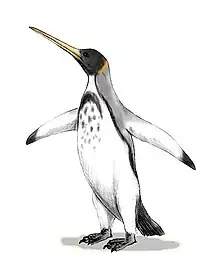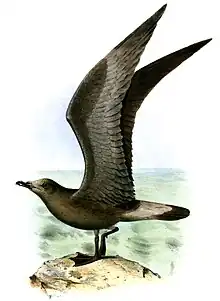| Megadyptes | |
|---|---|
 | |
| Scientific classification | |
| Domain: | Eukaryota |
| Kingdom: | Animalia |
| Phylum: | Chordata |
| Class: | Aves |
| Order: | Sphenisciformes |
| Family: | Spheniscidae |
| Genus: | Megadyptes Milne-Edwards, 1880 |
| Species | |
Megadyptes ("large diver") is a genus of penguins from New Zealand.
Species
The yellow-eyed penguin (Megadyptes antipodes) is the sole extant species in the genus Megadyptes. A smaller, recently extinct species, the Waitaha penguin (M. waitaha), was described in 2009.[1] A 2019 study recommended classifying the Waitaha penguin as M. a. waitaha, a subspecies of the extant yellow-eyed penguin.[2] The same 2019 study described M. a. richdalei, a recently extinct dwarf subspecies from the Chatham Islands.[2]
Range
Until recently, it was assumed that yellow-eyed penguins were widespread and abundant before the arrival of Polynesian settlers in New Zealand. However, genetic analysis has since revealed that its range only expanded to include mainland New Zealand in the past 200 years. Yellow-eyed penguins expanded out of the Subantarctic to replace New Zealand's endemic Waitaha penguin (M. waitaha). The Waitaha penguin became extinct between about 1300 and 1500, soon after Polynesian settlers arrived in New Zealand.[1][3] Jeremy Austin, a member of the team that discovered the Waitaha penguin, said, "Our findings demonstrate that yellow-eyed penguins on mainland New Zealand are not a declining remnant of a previous abundant population, but came from the subantarctic relatively recently and replaced the extinct Waitaha penguin."[4]
A 2019 study recommended classifying the Waitaha penguin as M. a. waitaha, a subspecies of the extant yellow-eyed penguin.[2] If this taxonomic revision is confirmed, then Megadyptes antipodes is native to mainland New Zealand after all.
A dwarf subspecies from the Chatham Islands, M. a. richdalei, is extinct.[2] The modern population of yellow-eyed penguins does not breed on the Chatham Islands.
Today, yellow-eyed penguins are found in two distinct populations.[5] The northern population extends along the southeast coast of the South Island of New Zealand, down to Stewart Island and Codfish Island.[6][7] It includes four main breeding areas in Banks Peninsula, North Otago, Otago Peninsula and the Catlins. It is also referred to as the mainland population.[7] The southern population includes the Subantarctic Auckland Islands and Campbell Island.[5] There is little gene flow between the northern and southern populations as the large stretch of ocean between the South Island and Subantarctic region and the subtropical convergence act as a natural barrier.[8]
References
- 1 2 Boessenkool, Sanne; Austin, Jeremy J; Worthy, Trevor H; Scofield, Paul; Cooper, Alan; Seddon, Philip J; Waters, Jonathan M (2009-03-07). "Relict or colonizer? Extinction and range expansion of penguins in southern New Zealand". Proceedings of the Royal Society B: Biological Sciences. 276 (1658): 815–821. doi:10.1098/rspb.2008.1246. ISSN 0962-8452. PMC 2664357. PMID 19019791.
- 1 2 3 4 Cole, T.L.; Ksepka, D.T.; Mitchell, K.J.; Tennyson, A.J.; Thomas, D.B.; Pan, H.; Zhang, G.; Rawlence, N.J.; Wood, J.R.; Bover, P.; Bouzat, J.L. (2019). "Mitogenomes uncover extinct penguin taxa and reveal island formation as a key driver of speciation". Molecular Biology and Evolution. 36 (4): 784–797. doi:10.1093/molbev/msz017. PMID 30722030.
- ↑ "Sentinels of change: prehistoric penguin species raise conservation conundrum". Sciblogs. Retrieved 2019-09-29.
- ↑ "New penguin species found in New Zealand". www.adelaide.edu.au. Retrieved 2022-04-22.
- 1 2 "Distribution and habitat". Yellow-eyed Penguin Trust. Retrieved 2019-09-29.
- ↑ "Yellow-eyed penguin | New Zealand Birds Online". www.nzbirdsonline.org.nz. Retrieved 2019-09-27.
- 1 2 "Yellow-eyed penguin/hoiho". www.doc.govt.nz. Retrieved 2019-09-29.
- ↑ Boessenkool, Sanne; Star, Bastiaan; Waters, Jonathan M.; Seddon, Philip J. (June 2009). "Multilocus assignment analyses reveal multiple units and rare migration events in the recently expanded yellow-eyed penguin (Megadyptes antipodes)". Molecular Ecology. 18 (11): 2390–2400. doi:10.1111/j.1365-294X.2009.04203.x. PMID 19457203. S2CID 205361804.

